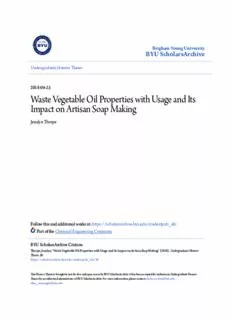
Waste Vegetable Oil Properties with Usage and Its Impact on Artisan Soap Making PDF
Preview Waste Vegetable Oil Properties with Usage and Its Impact on Artisan Soap Making
BBrriigghhaamm YYoouunngg UUnniivveerrssiittyy BBYYUU SScchhoollaarrssAArrcchhiivvee Undergraduate Honors Theses 2018-04-23 WWaassttee VVeeggeettaabbllee OOiill PPrrooppeerrttiieess wwiitthh UUssaaggee aanndd IIttss IImmppaacctt oonn AArrttiissaann SSooaapp MMaakkiinngg Jenalyn Thorpe Follow this and additional works at: https://scholarsarchive.byu.edu/studentpub_uht Part of the Chemical Engineering Commons BBYYUU SScchhoollaarrssAArrcchhiivvee CCiittaattiioonn Thorpe, Jenalyn, "Waste Vegetable Oil Properties with Usage and Its Impact on Artisan Soap Making" (2018). Undergraduate Honors Theses. 30. https://scholarsarchive.byu.edu/studentpub_uht/30 This Honors Thesis is brought to you for free and open access by BYU ScholarsArchive. It has been accepted for inclusion in Undergraduate Honors Theses by an authorized administrator of BYU ScholarsArchive. For more information, please contact [email protected], [email protected]. Honors Thesis TITLE WASTE VEGETABLE OIL PROPERTIES WITH USAGE AND ITS IMPACT ON ARTISAN SOAP MAKING by Jenalyn Thorpe Submitted to Brigham Young University in partial fulfillment of graduation requirements for University Honors Chemical Engineering Department Brigham Young University June 2018 Advisor: Randy Lewis Honors Coordinator: Dean Wheeler ii ABSTRACT WASTE VEGETABLE OIL PROPERTIES WITH USAGE AND ITS IMPACT ON ARTISAN SOAP-MAKING Jenalyn Thorpe Chemical Engineering Department Bachelor of Science This thesis examines the impact of vegetable oil usage in industrial and home settings on the properties of the vegetable oil and how its usage in soap affects the final product. Waste vegetable oil (WVO) is often used to make soap as a way to be more environmentally-friendly and create soap at a low cost in developing countries. Two settings are examined: home usage (i.e. short-term, small-scale usage) and industrial (i.e. long-term, almost continuous usage). This thesis found that lightly used oil (household use) had little to no impact on the quality of the oil, except for its scent. This resulted in a bar of soap that had very similar properties to soap made from fresh oil, except for it was somewhat brittle. However, when oil was used extensively the properties of the oil changed dramatically, including a deepening of the color, free fatty acid (FFA) content increase to approximately 5%, and an acquired scent. This resulted in a bar of soap that was darker in color, and had less lather than fresh oil soap (by 1.4 on a scale of 5). The industrial WVO had the advantage of reacting quickly with the lye to make soap, allowing the soap making process to take less time, and for the bar of soap to reach a usable stage quicker, most likely because of the high FFA%. These results demonstrate that using lightly or heavily used vegetable oil in soap results in a high-quality product for a very low cost. iii iv ACKNOWLEDGEMENTS I would like to acknowledge the help and contribution of my team members through Global Engineering Outreach: Abbey Wilson, Connor Weeks, and Joshua Frei. They were instrumental to making (so many) batches of soap, researching, communicating with Porcón—and ultimately implementing the process developed in the Granja Porcón community. I’m also grateful to Randy Lewis for his mentorship; to Matthew Memmott, for agreeing to be my reader and providing support; to Laura Kneib (owner of F.R.O.G. Soap) for her willingness to share her expertise on working with waste vegetable oil (WVO) in soap-making; to Sam Thorpe, for his continued support and encouragement. v vi TABLE OF CONTENTS TITLE .............................................................................................................................................. i ABSTRACT ................................................................................................................................... iii ACKNOWLEDGEMENTS ............................................................................................................ v TABLE OF CONTENTS .............................................................................................................. vii TABLE OF TABLES .................................................................................................................... ix TABLE OF FIGURES ................................................................................................................... ix 1. INTRODUCTION ...................................................................................................................... 1 2. EXPERIMENTAL ...................................................................................................................... 4 3. RESULTS AND DISCUSSION ............................................................................................... 10 4. CONCLUSIONS..................................................................................................................... 244 REFERENCES ........................................................................................................................... 277 APPENDIX ................................................................................................................................. 299 vii viii TABLE OF TABLES Table 1: Scale for Measure of Soap Quality ................................................................................... 7 Table 2: Linear Regression Parameters for FFA Content vs Time ............................................... 12 Table 3: Characteristics of Industrial WVO vs New Oil Soap ................................................... 222 Table 4: Characteristics of Household WVO vs New Oil Soap ................................................. 233 Table 5: Summary of NaOH (g) to Titrate 1 mL of Each Oil Sample and Corresponding FFA% ..................................................................................................................................................... 299 Table 6: Summary of Average HSV Values for Industrial and Household Use Oil Samples .... 311 Table 7: Summary of Scent Test Perception Numbers for Industrial and Household Use Oil Samples ....................................................................................................................................... 322 TABLE OF FIGURES Figure 1: Saponification reaction. Image is modified from Đokić, et al. ....................................... 2 Figure 2: Soap mixture at trace. ...................................................................................................... 9 Figure 3: Free fatty acid content of industrial peanut oil with time, with 95% confidence interval bands. ............................................................................................................................................ 11 Figure 4: FFA content (%) plotted against time (i.e. sample number) for household use samples. ....................................................................................................................................................... 13 Figure 5: Industrial oil samples, from clean (0) to WVO (W)...................................................... 14 Figure 6: HSV values of industrial oil with time. ....................................................................... 166 Figure 7: A comparison of home-usage oil samples, from least used (left) to most used (right). ..................................................................................................................................................... 177 Figure 8: HSV values over time for household use oil samples. ................................................ 188 ix
Description: